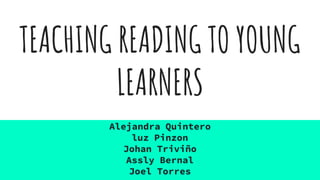
Reading
- 1. TEACHING READING TO YOUNG LEARNERS Alejandra Quintero luz Pinzon Johan Triviño Assly Bernal Joel Torres
- 2. 1. Introductory activity 2. Why to teach the reading 3. What reading is 4. Factor to consider when teaching reading 5. How to teach pronunciation 6. summary 7. closing activity contents
- 3. Short conversations This time give the students a sentence from the reading. The students then have a conversation with a partner about the sentence. Story telling Prepare a short personalized narrative about something related to the topic of the reading. Be creative with the story. Videos There is so much good free content available these days. First, find a short video relating to the topic of the reading. I would suggest something around three minutes long. Introductory activity
- 4. In teaching a second language, you have the previous knowledge that the young learners in reading possesses to relate them to the language that is being learned, aspects such as vocabulary, grammatical structures, context and meaning allow the approach to a second language. Reading is important because it develops the brain and our brain is a muscle that needs exercise, therefore, learning the written word, is one way to develop the reading ability. Teaching young children to read helps them develop their language skills and their critical mind. why To teaching reading
- 5. Every language has a printed coding of its sounds and concepts, in order to understand the grouping of these codes, some previous concepts and skills are required to give meaning to these characters. Reading consists of two related processes: word recognition and comprehension. Word recognition refers to the process of perceiving how written symbols correspond to one’s spoken language. Comprehension is the process of making sense of words, sentences and connected text. What is teaching reading
- 6. ● Knowledge previous about reading in a native language. ● What is the purpose of reading, is for pleasure or for information. ● Make reading exercise easier and dynamics for young, because in this age they get bored faster. ● Vision problems. ● Don't use of the block letters because for the young learners is more difficult reading. what factors to consider when teaching reading
- 7. Phonics-based instruction is to teach the young learners develop literacy skills within the context of literature with authentic story-books for developing intellectual and creative goals, for theses reasons the stories can be enjoyed by young learners and develop cognitive and social skills. how to teach reading Phonics-based instruction is to teach the young learners that printed letters represent speech sounds heard in words, that help children see the correspondence between letters and sounds.
- 8. The language experience approach Another method, the language experience method, uses learners’ own words to help them read. Unlike other methods of teaching reading, this method is grounded in personalized learning. In this method, every child learns different words. Children often find this method very easy because they learn words they are already familiar with. This approach involves a shared experience such as common school experiences, excursions and everyday happenings. In other words, first hand experiences are reflected through the texts written through the language experience approach. This approach is more effective when it is combined with other methods of teaching reading. what techniques to use to teach reading
- 9. ● Names ● Print-rich environment ● learning centers ● The phonetic method ● Choose interesting material for the learn ● Work in groups what techniques to use to teach reading ● Language experiences ● own words ● Questioning techniques ● Comprehension strategies ○ context clues and print conventions ○ graphic organizers
- 10. summary ● Teaching young children to read helps them develop their language skills and their critical mind. ● Comprehension is the process of making sense of words, sentences and connected text, which is a background knowledge and the use of vocabulary; that is why teaching to read is an important educational goal. ● The language experience approach helps to guide each student to increase their personally reading skill, through our knowledge. ● It might take into account to Make reading exercise easier and dynamics for young, because in this age they get bored faster
- 11. 1. Creative Writing Ask students to choose 10-15 words from the text. You can provide categories for the words e.g. the most interesting words / the most important words. Students then write a text using the words. This text could be a story, poem or news report. 2. Finding Related News After students have finished reading, they can browse on the internet for a new related to something they read, for example: if they read something about moral and values, they can find examples of altruism on the web and they can share that information with their classmates. closing activity